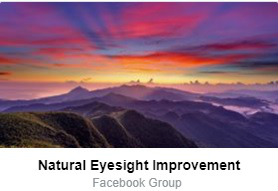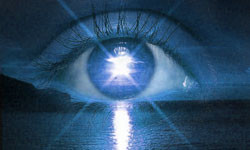In my last blog post I suggested that I would talk more in detail about patterns of the right way to go about looking at things.
The idea of “staring” is a big no-no in literature about the Bates method. So people trying to follow it have gotten an idea of what staring is and they throw the baby out with the bath water and avoid the very things that would be helping their vision to improve. I know because I went through that too. The idea makes a certain amount of sense. Keep your eyes moving, because your eyes were meant to move. You’ve frozen them up and suppressed their natural movement. But be careful with that idea. If you don’t look at something intently, down to the smallest detail, how are you supposed to see it? If you don’t spend a moment to really examine the details immediately next to it, how are you supposed to form a good picture of what you’re looking at? When will your visual system have an opportunity to orient itself when you keep bouncing your eyes around too much?
So that brings me to what I want to write about today. And I’m not sure how much this applies to everyone working on improving their vision with the Bates method. I would love to hear some feedback on where you are with the general concept of moving your eyes or avoiding staring, and if what I’m describing makes sense. The funny thing is that people who are new to vision improvement might have an easier time at this than people who have reprogrammed themselves with bad habits related to trying to keep their eyes moving all the time.
My instructions in the Applying the Bates Method article, as of writing (I’ll probably update it soon), describes in Part 2 a way of shifting your attention between two points a shorter and shorter distance apart and looking for smaller and smaller details. I’m going to suggest something a little different. Here goes.
In order to see a point and the surrounding details better, look at what is immediately next to the point. Not a certain distance away, but I mean truly adjacent to it (adjacent means immediately beside). It will be the smallest speck you can kind of, or almost, perceive as being next to it. Then repeat it, finding another speck next to the second one, even if you have to partly imagine it because it’s so blurry or indecipherable. In doing this you’re looking at what you can see, not just what you think you’re supposed to see, so more often than not you might be just looking at different pieces of indecipherable blur. But also work on this with something close enough that you can remain engaged and see stuff.
Once you’ve done that, keep repeating the process. You might find your gaze slowly moving in one direction or another as the adjacent pieces of detail lead you somewhere, and that’s fine. You don’t have to keep looking at the same thing you started with.
In looking at things this way, you’re accomplishing several things. When you try to determine an adjacent detail, you’ll be looking at a small detail out of necessity, without having to try to make it small. You have a reason to look for a small detail other than me telling you to.
Your shifts will become shorter and shorter, and you’ll have an easier time shifting your attention such small distances as a matter of routine. This will encourage your eyes to also make the smallest shifts, microsaccades, which are involuntary, meaning you don’t direct the movement and it seems to happen on its own. The eyes of people with blurry vision don’t perform enough microsaccades. It’s a function that you have suppressed by misusing your eyes.
You will learn to become engaged in what you’re looking at. Genuine interest is a huge part of seeing and perceiving. If you don’t allow yourself to dig in and find out how the pieces fit together and what’s next to what, you’re demonstrating that you are not really interested in seeing, because seeing is all about putting together a lot of individual details, each in its own spot, to form an image that makes sense. Your visual system will take care of the grunt work there, but you have to demonstrate that it’s what you want so that your visual system has a clear and congruent objective. You’re rife with contradictions in the way you’re using your eyes, so this whole process is a way of clearing these things up so you don’t just confuse your visual system with mixed messages (and mixed metaphors, sorry).
You’re giving your visual system a chance to orient itself and focus your eyes correctly. It will do this on its own, given the right conditions. And this is what you’ve been aiming for, after all: focused vision with a sharp image. It’s what vision improvement is all about, and it’s the final step that you have no direct control over. Your lack of control in that final step is illustrated over and over by the way people suddenly get flashes or longer moments of clear vision and just as suddenly lose it. You have to do things right to pave the way for your visual system to take care of this as the final step.
And to repeat something I said on the forum recently –
You can think of your vision as improved every time you look at a detail more closely that you were kind of looking in the general direction of but didn’t actually look at until now. It doesn’t have to be more focused, or clearer, for your vision to be better, so don’t get hung up on judging your vision by how focused the image appears to be compared to a moment ago. Judge it by what details you can perceive in what you’re looking at that you didn’t notice before. Every little thing matters. Every time you perceive something better because you looked directly at it, it’s an accomplishment, and you’re reinforcing the right pattern. Eventually of course the focus needs to improve too, and that should happen in short clear flashes at first. But the order these things happens in I think generally is the reverse of what people tend to think. People want the image to be clear so that they can look at things. But really you need to look at things better and appreciate each thing you see, and in using the visual system better you’re encouraging it to properly focus the image. It takes determination, having to keep looking at things that aren’t clear and forcing yourself to notice little things, constantly, without getting discouraged by the fact that a person with good vision can just look at it and it’s already clear. It’s about not fighting your eyes in their focus and doing the best you can in using your visual perception fully, for your part, with what it is right now, while putting a lot of trust in the idea that it’s going to pay off with better focused vision before long.
get help on our Facebook Group!

I founded iblindness.org in 2002 as I began reading books on the Bates Method and became interested in vision improvement. I believe that everyone who is motivated can identify the roots of their vision problems and apply behavioral changes to solve them.

David,
I totally agree. A year or two ago, I discovered this fact. I realized I had misinterpreted the whole idea of shifting, likely due to well-meaning but misguided teaching from books and internet. I truly think you are on to something here. I hope people with this “darting gaze syndrome” (not to be confused with nystagmus, which I’ve also read about!) will be able to discard this habit when they realize it doesn’t work in most situations. If one can both let their eyes relax and let micro movents occur simultaneously, the vision often improves by a good amount within moments.